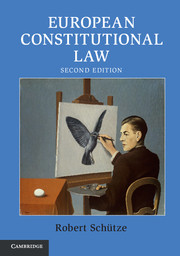Book contents
- Frontmatter
- Dedication
- Summary Contents
- Contents
- List of Illustrations
- List of Tables
- List of Cases
- List of Secondary Law
- Table of Equivalents
- List of Abbreviations
- Acknowledgements
- Introduction: European Constitutional Law
- Part I Constitutional Foundations
- Part II Governmental Powers
- 7 Legislative Powers: Competences and Procedures
- 8 External Powers: Competences and Procedures
- 9 Executive Powers: Competences and Procedures
- 10 Judicial Powers I: (Centralised) European Procedures
- 11 Judicial Powers II: (Decentralised) National Procedures
- 12 Judicial Powers III: EU Fundamental Rights
- Appendices
- Index
- References
11 - Judicial Powers II: (Decentralised) National Procedures
from Part II - Governmental Powers
- Frontmatter
- Dedication
- Summary Contents
- Contents
- List of Illustrations
- List of Tables
- List of Cases
- List of Secondary Law
- Table of Equivalents
- List of Abbreviations
- Acknowledgements
- Introduction: European Constitutional Law
- Part I Constitutional Foundations
- Part II Governmental Powers
- 7 Legislative Powers: Competences and Procedures
- 8 External Powers: Competences and Procedures
- 9 Executive Powers: Competences and Procedures
- 10 Judicial Powers I: (Centralised) European Procedures
- 11 Judicial Powers II: (Decentralised) National Procedures
- 12 Judicial Powers III: EU Fundamental Rights
- Appendices
- Index
- References
Summary
Introduction
National courts are the principal judicial enforcers of European law. ‘Ever since Van Gend en Loos the Court has maintained that it is the task of the national courts to protect the rights of individuals under [Union] law and to give full effect to [Union] law provisions.’ Indeed, whenever European law is directly effective, national courts must apply it; and wherever a Union norm comes into conflict with national law, each national court must disapply the latter. The Union legal order thereby insists that nothing within the national judicial system must prevent national courts from exercising their functions as ‘guardians’ of the European judicial order. In Simmenthal, the Court thus held that each national court must be able to disapply national law – even where the national judicial system traditionally reserves that power to a central constitutional court:
[E]very national court must, in a case within its jurisdiction, apply [Union] law in its entirety and protect rights which the latter confers on individuals and must accordingly set aside any provision of national law which may conflict with it, whether prior or subsequent to the [Union] rule. Accordingly any provision of a national legal system and any legislative, administrative or judicial practice which might impair the effectiveness of [European] law by withholding from the national court having jurisdiction to apply such law the power to do everything necessary at the moment of its application to set aside national legislative provisions which might prevent [Union] rules from having full force and effect are incompatible with those requirements which are the very essence of [Union] law.
Functionally, the direct effect (and supremacy) of European law transform every single national court into a ‘European’ court. This decentralised system differs from the judicial system in the United States in which the application of federal law is principally left to ‘federal’ courts. Federal courts here apply federal law, while state courts apply state law. The European system, by contrast, is based on a philosophy of cooperative federalism: all national courts are entitled and obliged to apply European law to disputes before them. National courts are however not full European courts. For while they must interpret and apply European law, they are not empowered to annul a Union act.
- Type
- Chapter
- Information
- European Constitutional Law , pp. 394 - 428Publisher: Cambridge University PressPrint publication year: 2015



